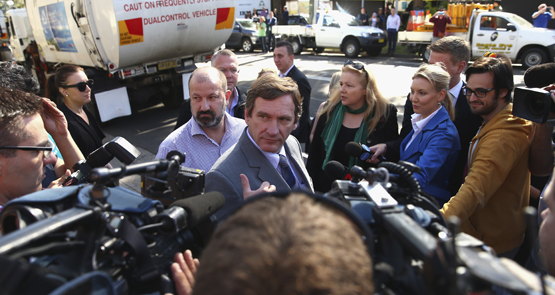Blacktown Mayor Stephen Bali speaks to the media at yesterday’s protest outside SBS headquarters in Sydney
The Socceroos were absent, and yet the ratings figure in this morning’s OzTAM data had a definite World Cup ring about them for SBS. Struggle Street, the network’s documentary on life in Mount Druitt, had 1.3 million national viewers last night, with 935,000 of those in the five metro capitals and 370,000 in regional markets. It’s the highest-rating documentary to air on SBS since Oztam ratings began.
Blacktown mayor Stephen Bali, along with some of the show’s participants, were allowed to watch the episode before it aired last night. Their concerns, publicly expressed, about their community’s depiction meant that in the lead-up to the premier, Struggle Street had blanket coverage across much of the Australian media. From last Thursday to today, Struggle Street had no fewer than 6935 mentions in the Australian media, according to Isentia figures. These mentions were concentrated in the media that people were the most likely to consume — namely television (2105 mentions) and radio (2566 mentions). Across the print media, the program had 148 mentions in the week leading up to the premiere (which included some very prominent placements in The Daily Telegraph), and another 2116 mentions came from online media sources.
To put that in some context, Joe Hockey was mentioned only slightly more often — 7511 mentions from April 30 to May 6, and that’s in the lead-up to the budget when you’d expect his profile to be at its highest. It would have taken hundreds of thousands of dollars for SBS to buy this much coverage commercially — but give the media a good story and you can have it for free, especially from tabloids searching for relevance in key markets that are under pressure.
Struggle Street had a genuine impact on the commercial networks’ ratings at 8.30pm. The program was most watched in Sydney (naturally, with 452,000 viewers) and was the most-watched program in the market, easily outscoring the more expensive programs such as Nine News, MasterChef, Reno Rumble and House Rules, most of which cost far more per episode to produce than Struggle Street. A further 256,000 watched in Melbourne, and then interest trailed away in Brisbane, Adelaide and Perth. In the regional markets, interest in regional NSW was the highest, with a total of 304,000 viewers. Nationally, it was the fourth most watched program in the country last night.
Interestingly, The Daily Telegraph campaigned fiercely against the doco and SBS (no doubt as part of its campaign for the west of Sydney), turning up to SBS managing director Michael Ebeid’s house on Tuesday to rail against his relative wealth. That is, of course, ironic seeing all the paper’s executives, who similarly claim to speak for Sydney’s west, live in the eastern or inner west of Sydney’s northern suburbs — well away from Mount Druitt. The Tele has learned its lesson well. Back on January 8, 1997, it ran a front-page photo of the graduating year 12 from Mount Druitt High under the headline “The class we failed”. The students took exception and successfully sued the paper. Now the Tele champions the area in its “Fair go for the west” campaign. For commercial reasons, of course — the bulk of its sales occur in the region each day.
Struggle Street has generally been positively reviewed this morning, though some of those who participated have said they still have concerns. The big test for Struggle Street will come next week. The network is airing the second and third episode back-to-back — a risky tactic, because the longer something runs, the more opportunities for viewers to switch off. If the bulk of last night’s viewers come back to watch, then it will have struck a chord with the audience. If there’s a sharp drop, you know it was a one night wonder.








Yes, the Telegraph’s legitimate representatives for Western Sydney: Alan Jones, Andrew Bolt, Miranda Devine, Tony Abbott and Christopher Monkton.
I’ve never been to Mount Druitt but know some of its Victorian rural equivalents well, and anything that gets our less photogenic environs & citizens on the telly is a good thing in my book. If the individuals featured feel they were misrepresented then of course they should get to air their grievance and seek redress, but there is far too much averting our gaze.
Nothing like the confected rage of the bien pissants such as Blot & his Hobbesean mate Price on 2GB to draw from the nastier crevices of society the punishers & pontificators who are the bulk of their slaish adherents.
If people want to be afraid of those with whom they share the streets, these resentful ravers & ranters should be made to wear a flashing light & ring a bell.